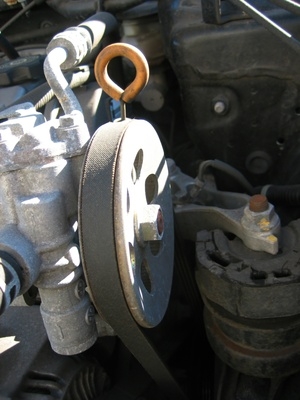
The timing belt runs the accessories in your car and keeps the crankshaft and the camshaft running in sync. If you have an "interference engine," a timing belt failure means massive damage and an expensive repair. The tensioner on the timing belt keeps the belt the proper tension so it moves properly. If your tensioner fails, your timing belt also fails. There is a recommended interval for changing your timing belt, as well as your tensioner. Some vehicles have a timing chain instead of a belt, which does not wear when the car is properly maintained.
Locate the timing belt in your car. The timing belt has teeth, which differentiates it from other belts in the car which are smooth on both sides. It synchronizes the camshaft which opens and shuts the valves at the top of your engine with the crankshaft which is turned by the explosions in the chambers moving the pistons at the bottom of the engine.
Follow the timing belt around until you come to the tensioner. The tensioner is a pulley that is only for applying tension to the belt. It is on the smooth side of the belt. If you have trouble identifying it, look at the side of the pulley for the tension mark.
Loosen the pulley so that timing belt loosens. Some pulleys adjust by turning and some require you to loosen an adjustment bolt with a wrench.
Unbolt the tensioner pulley from its mount with a wrench and replace it with the new tensioner pulley.
Adjust the timing belt back into its proper place using the tension mark on the pulley and crank the belt around so it does not jump teeth. Make sure the timing belt falls into the proper range on the tensioner.